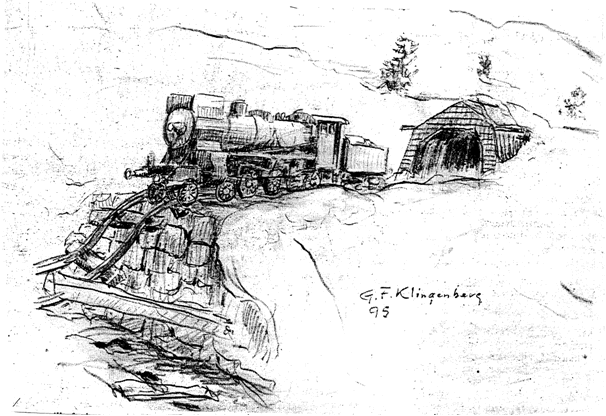



The organization of the Norwegian forces immediately after April 9, 1940 was not always according to the book. The main operations are well documented but in many localities small, anonymous groups got conflicting orders – or no orders at all. In November 2007 Gunnar F. Klingenberg told us about his experiences in those uncertain days.
On April 9, 1940 a 70-man artillery troop, with four Bofors light artillery guns, stood by, ready to defend the important Norwegian Hydro plant at Rjukan. (Just how important, became evident only later when the Heavy Water raid took place). The troop included many workers from the Hydro plant. After waiting for an attack that never came, the men received orders to leave – destination Numedal – and take with them three of the Bofors guns. Gunnar F. Klingenberg was in charge of one of these and late in the evening of April 20, after the anticipated German air raid finally came, the troop left Rjukan,
 The Germans had already occupied Kongsberg but the troop slipped by unnoticed – probably, they joked, because the German soldiers had been celebrating Hitler’s birthday and were too drunk to send out patrols. Norwegian forces had already demolished the bridges south of their first destination, Veggli, so they had to use an old narrow, timber-road. It was no easy task to drag equipment and guns up the steep inclines in the melting snow and ice.
The Germans had already occupied Kongsberg but the troop slipped by unnoticed – probably, they joked, because the German soldiers had been celebrating Hitler’s birthday and were too drunk to send out patrols. Norwegian forces had already demolished the bridges south of their first destination, Veggli, so they had to use an old narrow, timber-road. It was no easy task to drag equipment and guns up the steep inclines in the melting snow and ice.
At Veggli they loaded everything onto a train and joined the ‘Dagali Group’ at Rødberg.
Gunnar remembers that he placed his cannon close to the large Nore power station. He told us:“One of my men, Richardsen, was an engineer and he said that it would be easy to disconnect the Nore power from the grid and leave Oslo without electricity. We discussed this back and forth but decided that the action would probably only result in the Germans making reprisals on the people of Oslo.”
Shortly afterwards German aircraft attacked, and the battery shot down one of the planes. Locals found the wreck later in the mountains. Troop leader, Capt. Bruun, was furious that they had fired without his permission, and he gave them strict orders not to do so again. However, this did not stop them from firing at low-flying reconnaissance flights a few days later.
In the meantime the locals, on both sides of the mountains, had been working intensely to clear the snow from the road over to Geilo. “It was an impressive job,” said Gunnar, “the snow was 2 meters deep in places – and no snow-ploughs – men armed only with spades and shovels had to do the work. In the early morning sun the mountain scenery was breathtaking – but this was no vacation trip.”
The group reached Geilo in the morning of April 26. Almost immediately three Heinkel bombers attacked. “They came right over us and the temptation was too great; in spite of orders we fired at them. They peeled away and then dived again. As the bombs fell we fired and made a hit – the planes retired, one of them trailing smoke.” Later that day the group was ordered eastwards, via Ål and Gol to Hemsedal; then a new order – westward! The change of plans made for an exciting trip – the Germans were already on the way up Hallingdal towards Gol – could the group keep ahead of them? At Ål station, they loaded everything onto a train and headed over the mountains to Myrdal. The train parked under a snow-shelter just outside the station.
At about noon on the 28th a motorized ‘bogey’ appeared from the mouth of the Gravhals Tunnel carrying the remnants of a Norwegian support group which had been guarding the western entrance to the tunnel. They had with them the body of their officer – killed during the fierce fighting at Ørneberg.
(The day after the German invasion on April 9, the Norwegian military command had ordered the destruction of all tunnels on the Flåm railway, but the work had not been completed.)
Gunnar Klingenberg continued: “We knew that the Germans would eventually make their way through the tunnel so we sent in some men to lay charges in order to block it. They failed to do this so we decided to send an unmanned locomotive into the tunnel, hoping it would derail and effectively block a German advance.” The plan did not work, but it was only years later that Gunnar learned what had happened to the runaway train when he read a report in the book ‘Flåmsbanen’.1
Klingenberg continued: “At Myrdal the situation was chaotic. Capt. Bruun gave ordered us to give up and make our way down to Flåm on the Sognefjord. Some of the men who were familiar with the area took the equipment and artillery by train to Geilo. During the night, the rest of us marched through the Vatnehals Tunnel, and down the valley to Flåm. It was no easy task – in the pitch dark – with packs, skis and rifles. From Flåm we boarded a ferry and landed at Hermansverk on the other side of the Sognefjord. At a school in Gaular, on May 1, 1940 we received the order to cease resistance and return home as civilians. A German patrol arrested us at Lærdal and lodged us in the Lindstrøm hotel. After three days, Helge Ingstad, representing the Red Cross, came and secured our release. A ‘release’ that meant being trucked to Hønefoss by the Germans, who then marched us to the military camp at Hvalsmoen, ‘to get our discharge papers.’ However, we were there for 14 days.”

The report, quoted in ‘Flåmsbanen’, is by the German Lieutenant Fedler:
Towards evening on the 28th we reached the first buildings at Upsete. Ahead was our objective, the 6 km long Gravhals Tunnel … a black hole where the railway line disappears into the mighty snow-covered mountains. Here…the Norwegians made their final attempt to stop us….we were open to machinegun fire from both flanks… our only approach was along the railway line, all attempts to attack from the sides simply left us floundering in the snow… two comrades are dead and another wounded. After three hours skirmishing, suddenly all is still… the enemy has abandoned its position. Incomprehensively we shook our heads. How could they possibly have left such an ideal defensive position?
The Gravhals Tunnel stood undefended, and the ski equipment left behind by the Norwegians allowed us to explore the area thoroughly. But another surprise awaited: Just as we were about to enter the tunnel a locomotive, like a huge, black troll, came hurtling out of the darkness. At the last moment, we jumped aside. The locomotive swept two of our supply bogies from the tracks. We fired several shots – but to no avail, the troll was unmanned. It stopped meters in front of the demolished bridge over the river at Ljosandalen. (Lt Fedler was later promoted for his leadership during this action.)
‘Flåmsbanen’ by Ivar J. Gubberud og Helge Sunde. John Grieg Forlag P.53